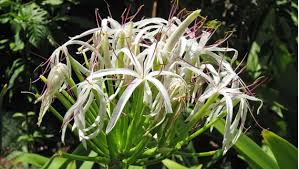New Discovery in Eastern Ghats: Crinum andhricum (GS Paper 3, Environment)

Context
- A remarkable discovery was made by botanists from the Botanical Survey of India in April 2023: a new flowering plant species, Crinum andhricum, found in the dry, rocky forests of the Sapparla Hills in the Eastern Ghats of Andhra Pradesh.
- The discovery was led by scientist L. Rasingam and his team, marking a significant addition to India’s botanical diversity.
- The plant, which belongs to the Amaryllidaceae family, has drawn attention for its unique features and the challenges it faces from environmental threats.
Key Features of Crinum andhricum
Crinum andhricum is a distinctive flowering species that exhibits several unique characteristics:
- Flowering: The plant blooms between April and June, with waxy white flowers. Each flower cluster contains 12 to 38 individual blooms.
- Flower Structure: The plant is notable for its oblanceolate (wide) perianth lobes, which set it apart from related species like Crinum amoenum and Crinum stracheyi. This morphological trait contributes to its identification as a distinct species.
- Size and Appearance: The plant grows up to 100 cm in height. Its elliptic leaves are large and have smooth, entire margins, adding to its striking appearance.
- Unique Pedicelled Flowers: Unlike many related species, Crinum andhricum features flowers that are pedicelled, meaning each flower is borne on its own stalk.
Habitat and Distribution
Crinum andhricum was discovered in the Sapparla Hills, located in the Alluri Sitarama Raju district of Andhra Pradesh, at an elevation of 1,141 meters above sea level. The region is characterized by dry, rocky forests, which provide a specific habitat for this species.
- Limited Distribution: The species has been observed in a restricted area, primarily around the Sapparla Hills viewpoint, where over 1,000 mature specimens have been recorded. The plant is not found in many other regions, which makes it vulnerable to habitat loss and environmental threats.
Conservation Concerns
While Crinum andhricum has been recorded in substantial numbers at its discovery site, the plant faces significant conservation challenges due to human-induced threats:
- Tourism: Increased tourism activity in the region poses a risk to the plant’s fragile habitat, with potential disturbances to its growing environment.
- Forest Fires: The dry forests of the Eastern Ghats are prone to wildfires, which could destroy the plant's habitat and threaten its survival.
- Grazing: Livestock grazing in the area also poses a danger, as it can lead to overgrazing and the degradation of the plant’s habitat.
IUCN Conservation Status
Given its limited distribution and the environmental threats it faces, Crinum andhricum has been assigned a preliminary conservation status of ‘Data Deficient’ by the International Union for Conservation of Nature (IUCN). This classification indicates that there is insufficient data to assess the plant’s conservation needs fully. Further research is needed to determine:
- Population trends: Whether the plant’s population is declining, stable, or increasing.
- Threat assessment: The impact of environmental threats like forest fires, grazing, and tourism on its habitat.
- Conservation actions: Effective measures that can be taken to protect the species and its ecosystem.
Research and Preservation Efforts
- Efforts are underway to study Crinum andhricum more thoroughly.
- Specimens of the plant have been preserved at the Central National Herbarium and the Deccan Regional Centre in Hyderabad for further research.
- Botanists are also exploring nearby regions to gather more information and assess the species’ full distribution range.
- By gathering more data on the plant's habitat and ecology, researchers hope to implement conservation strategies to safeguard Crinum andhricum and its natural environment.
- This could include measures to protect the area from human disturbances, such as tourism management and fire prevention strategies, as well as initiatives to raise awareness about the plant's significance.
Conclusion
- The discovery of Crinum andhricum in the Eastern Ghats represents an exciting addition to India’s botanical wealth.
- However, the species’ limited range and vulnerability to environmental threats underscore the importance of continued research and conservation efforts.
- The preliminary Data Deficient status from the IUCN calls for urgent action to ensure that this unique species does not face the risk of extinction before its conservation needs are fully understood.
- The preservation of the Sapparla Hills and its rich biodiversity is critical not only for Crinum andhricum but also for the many other species that share its delicate ecosystem.


